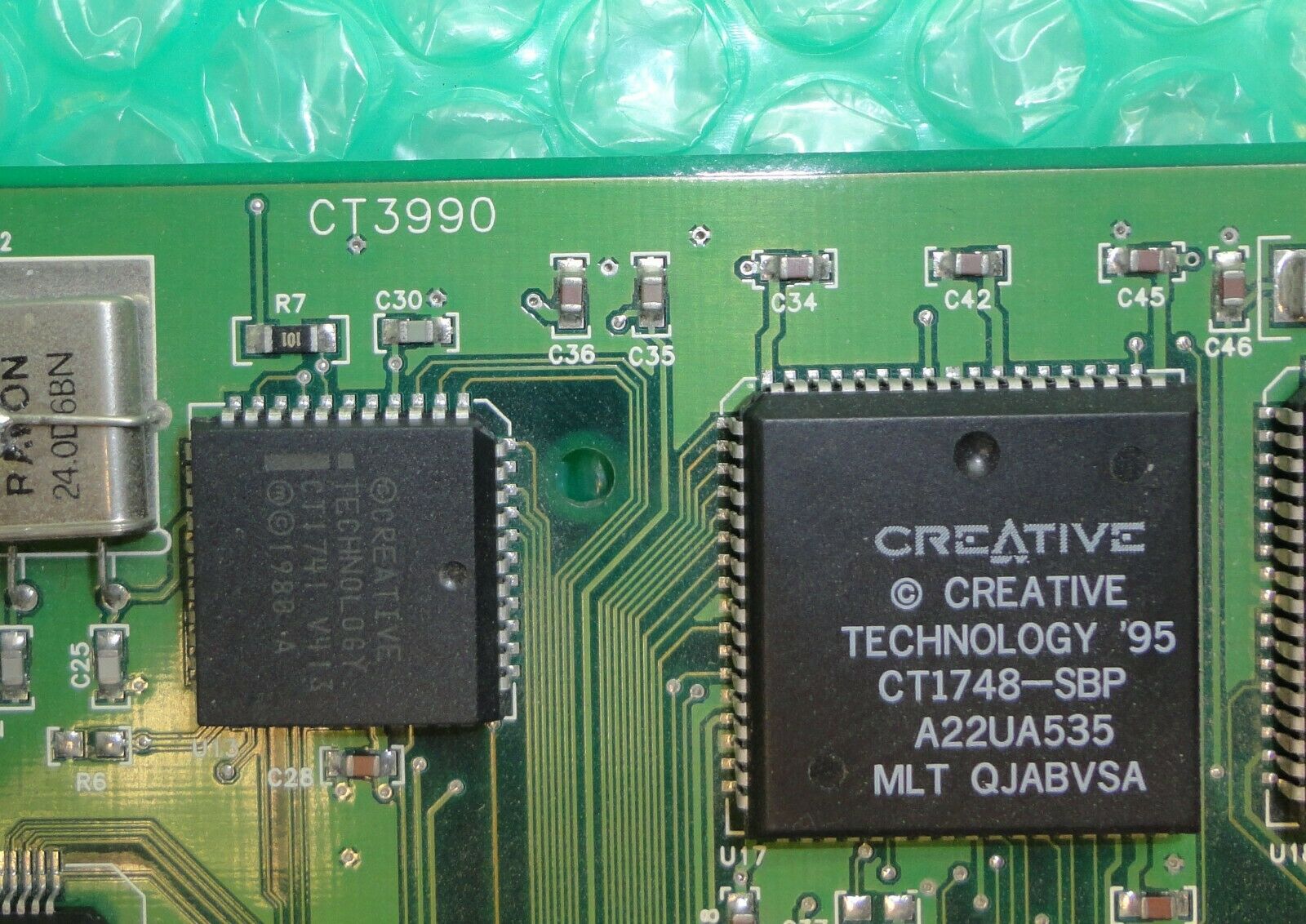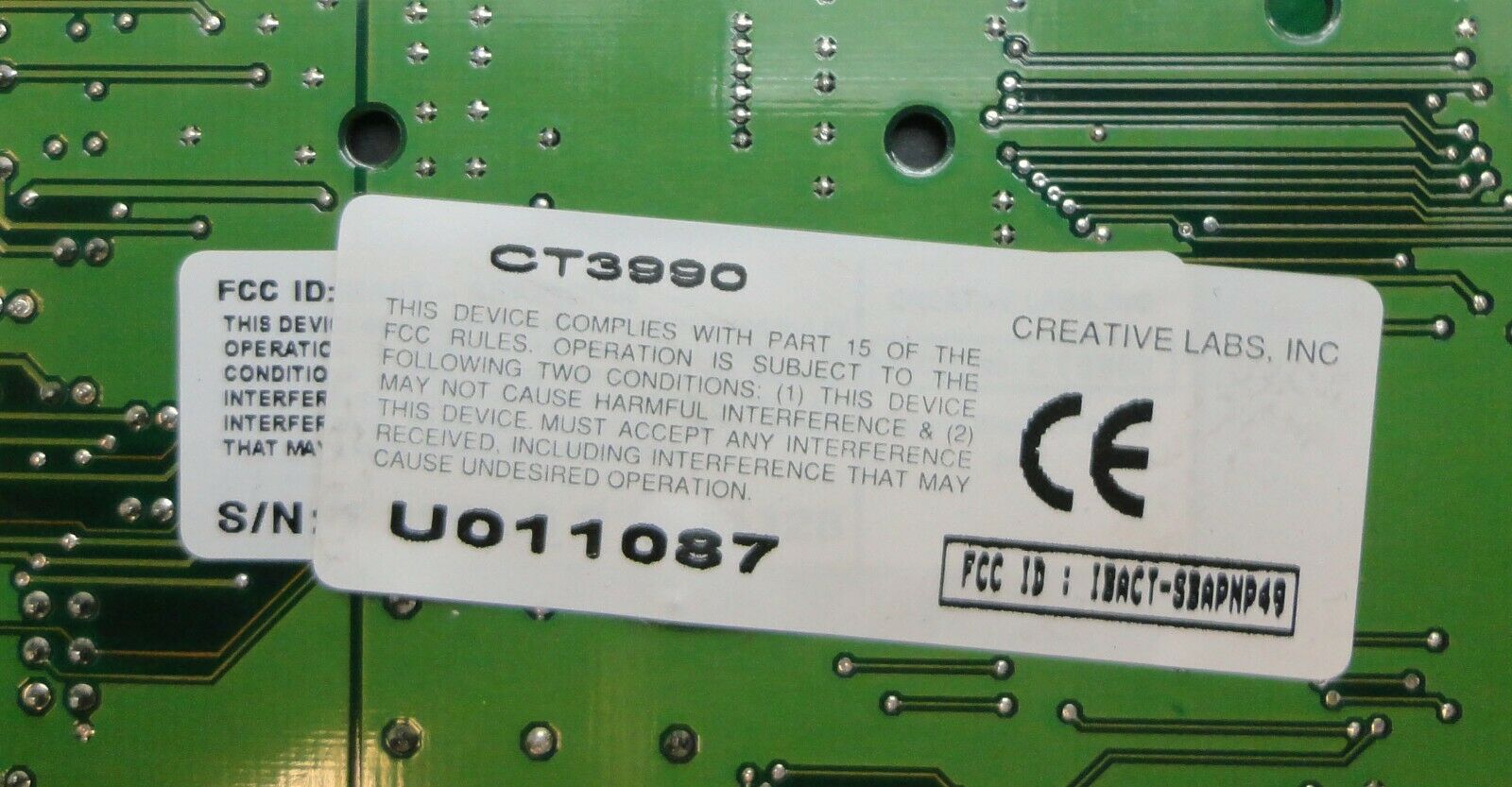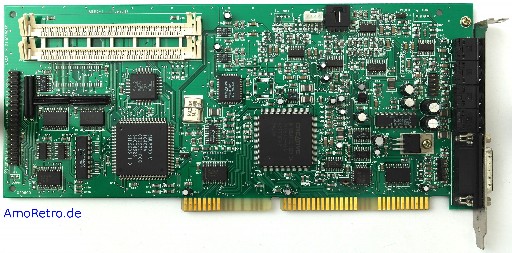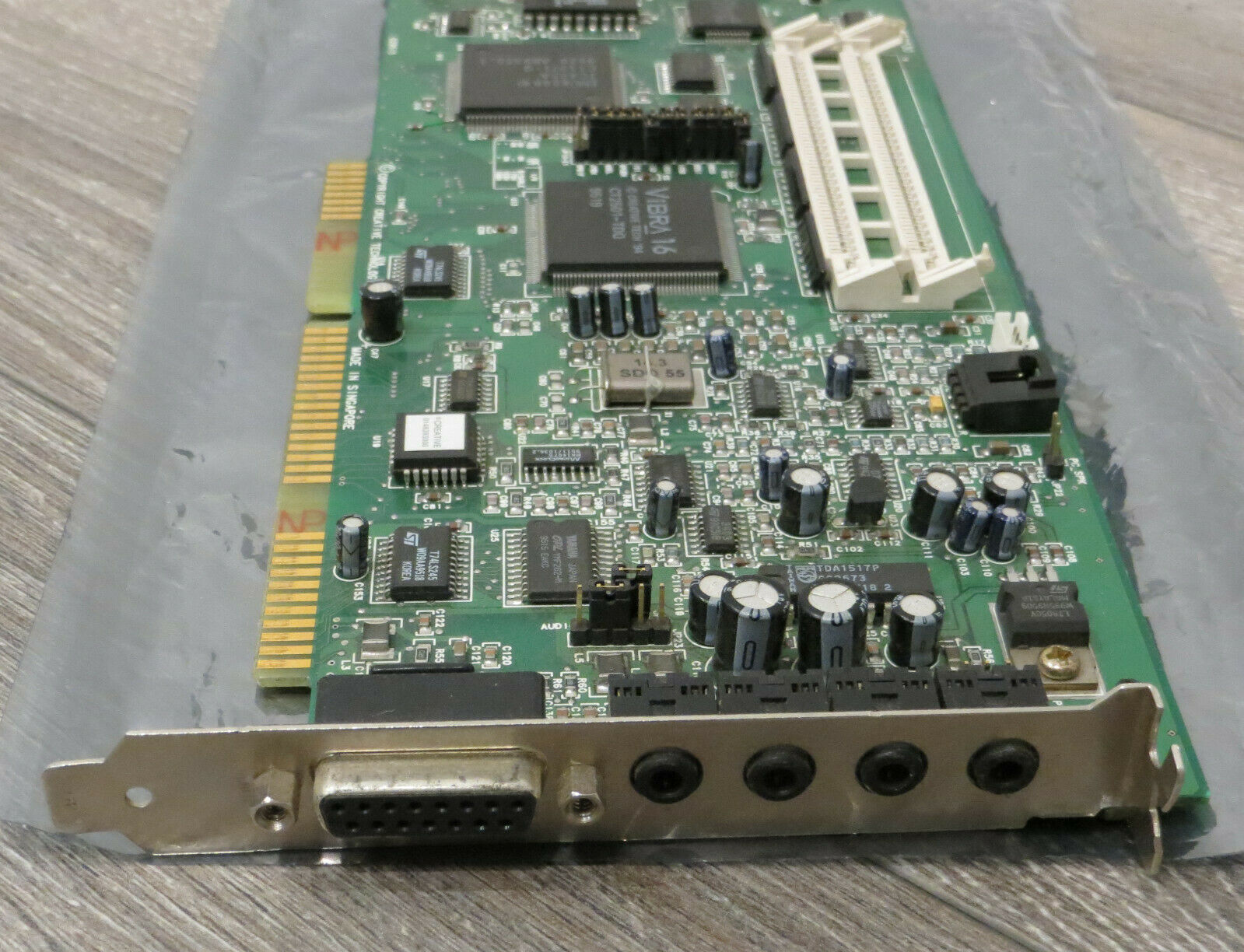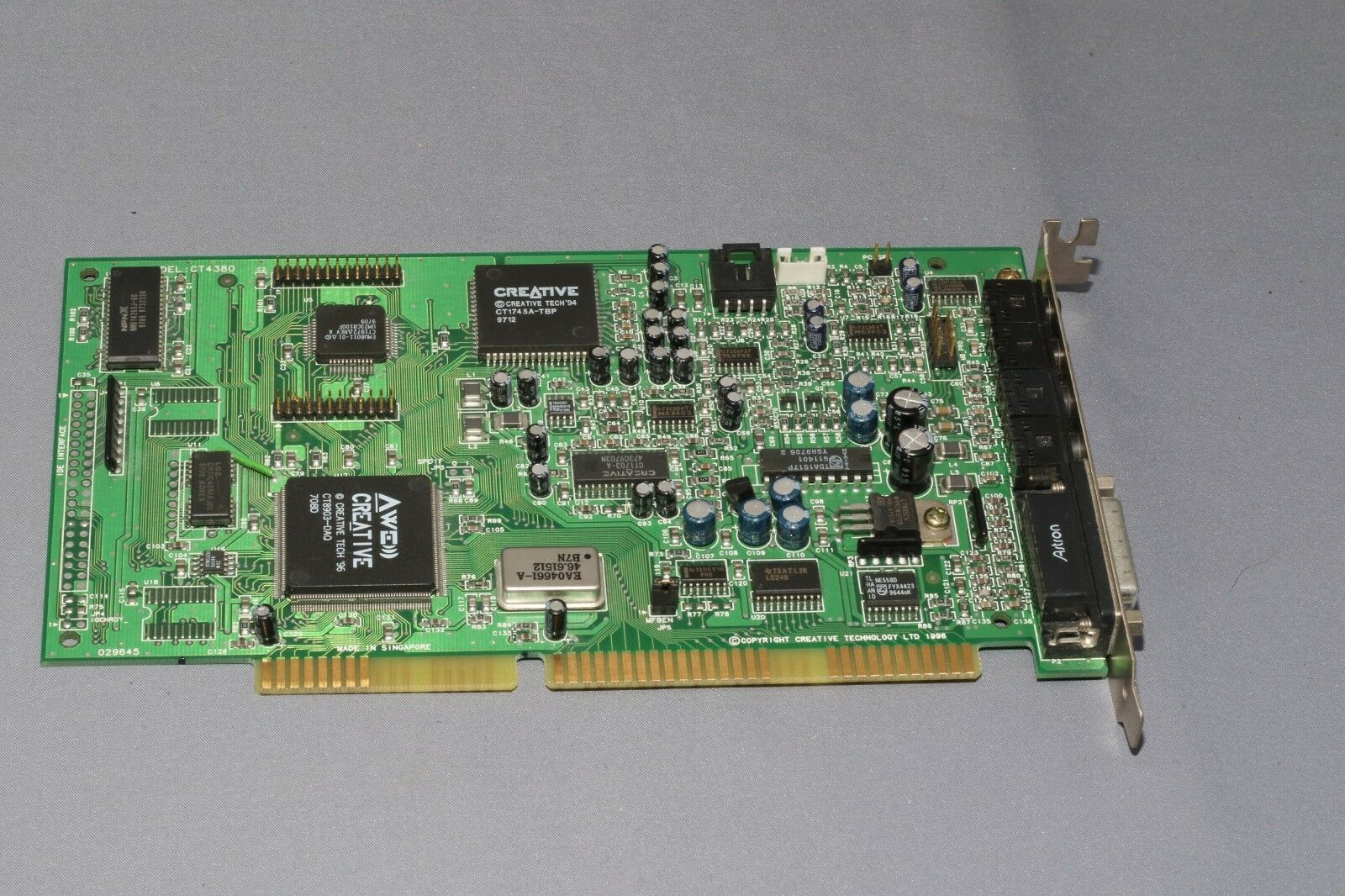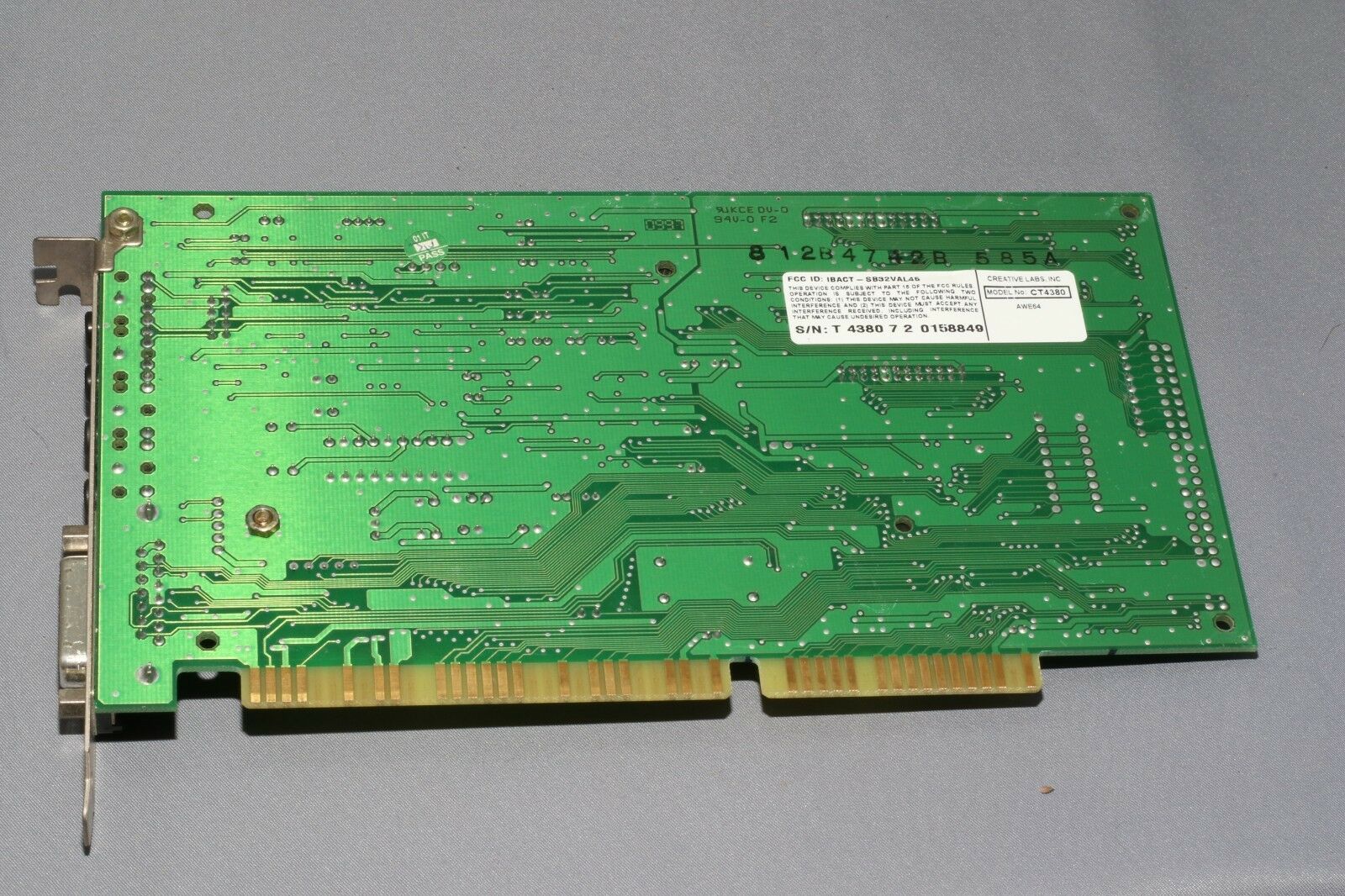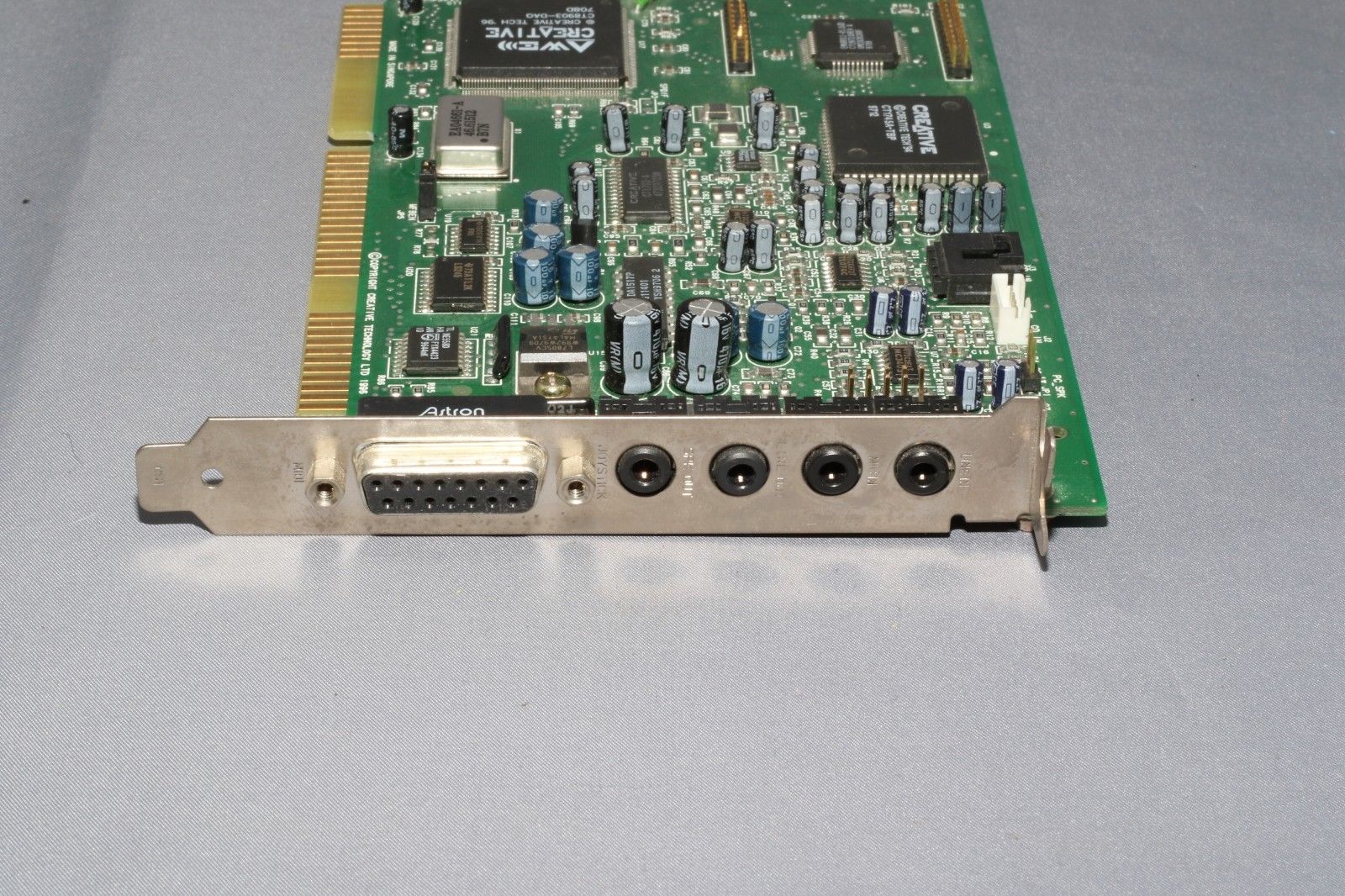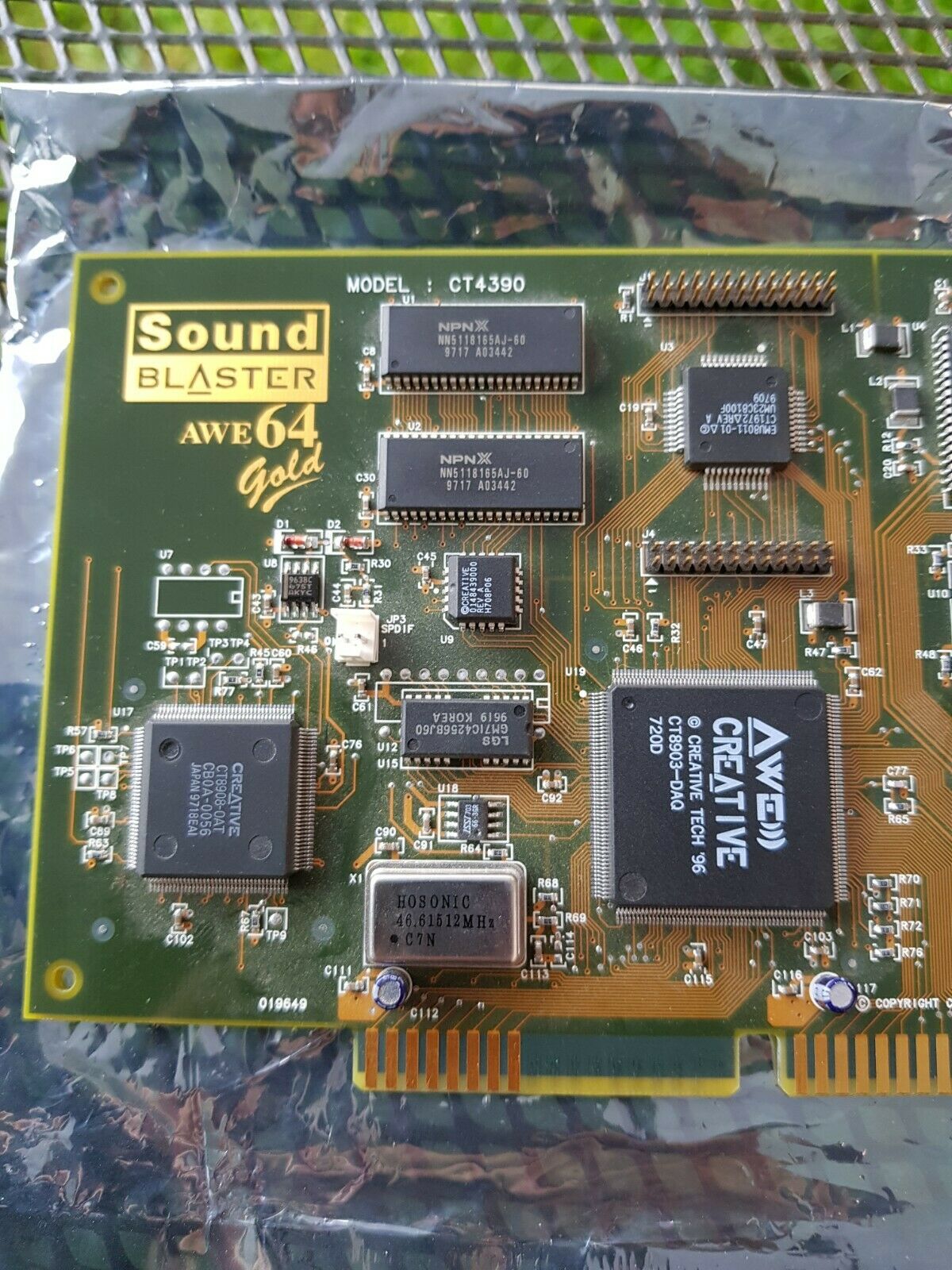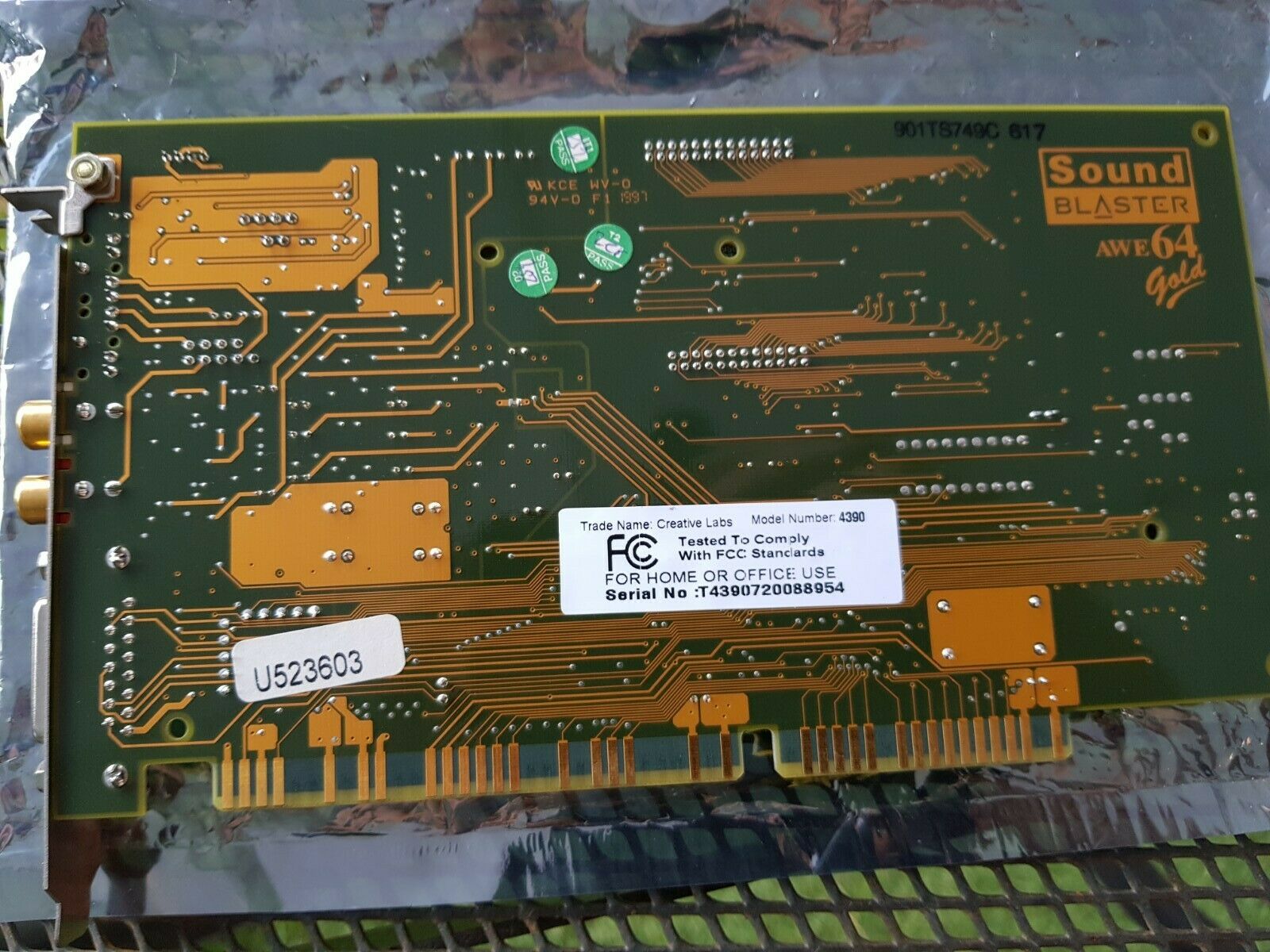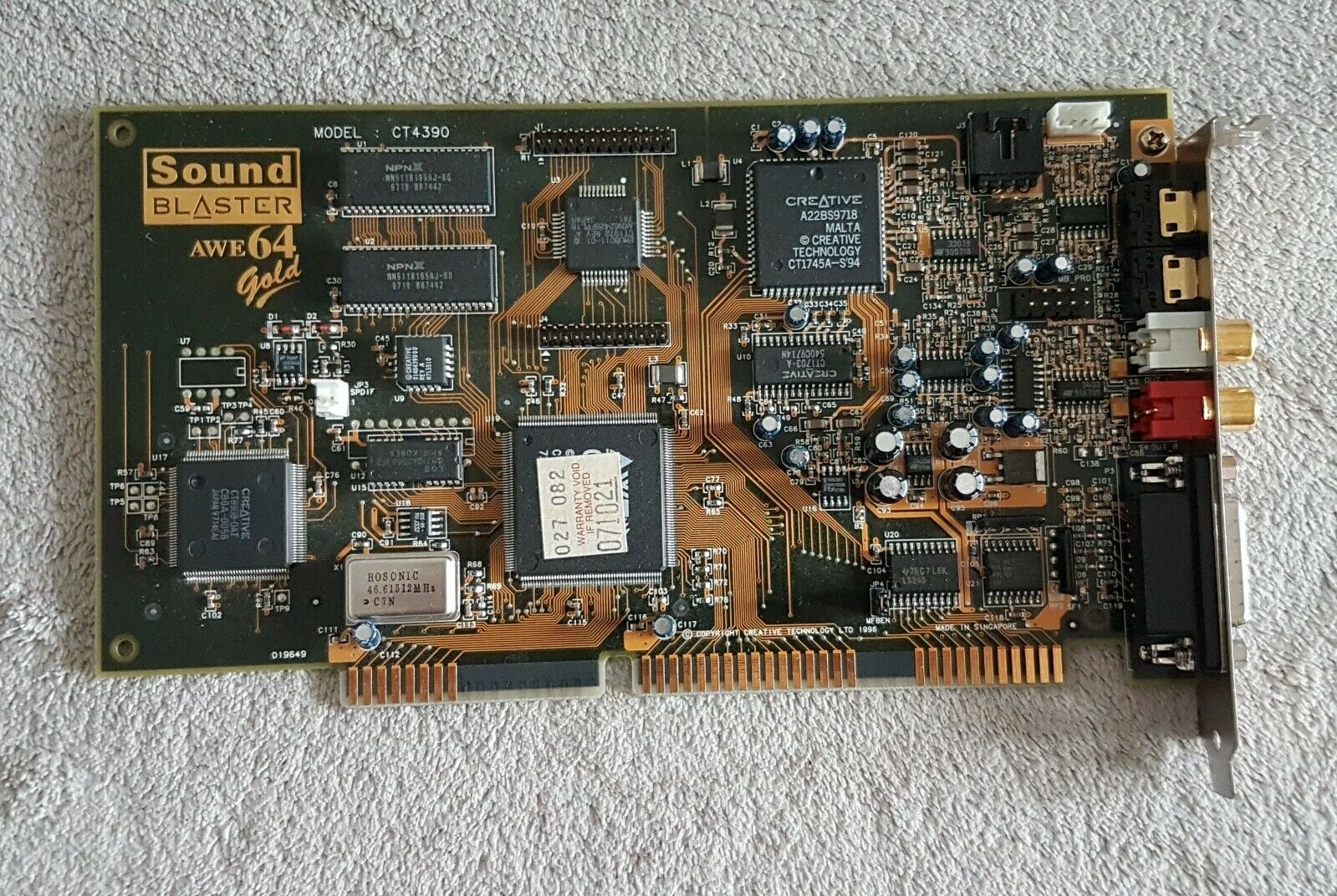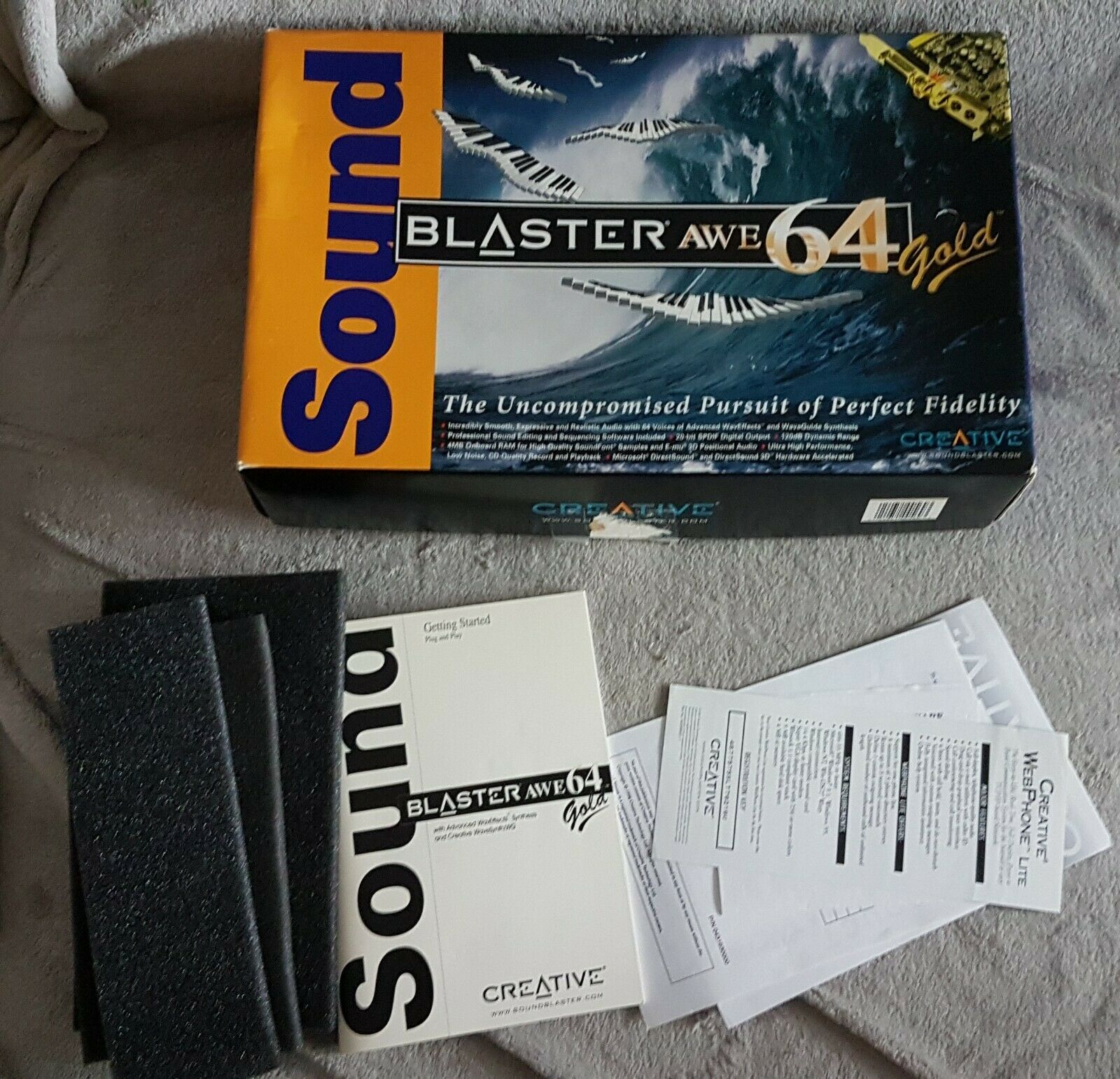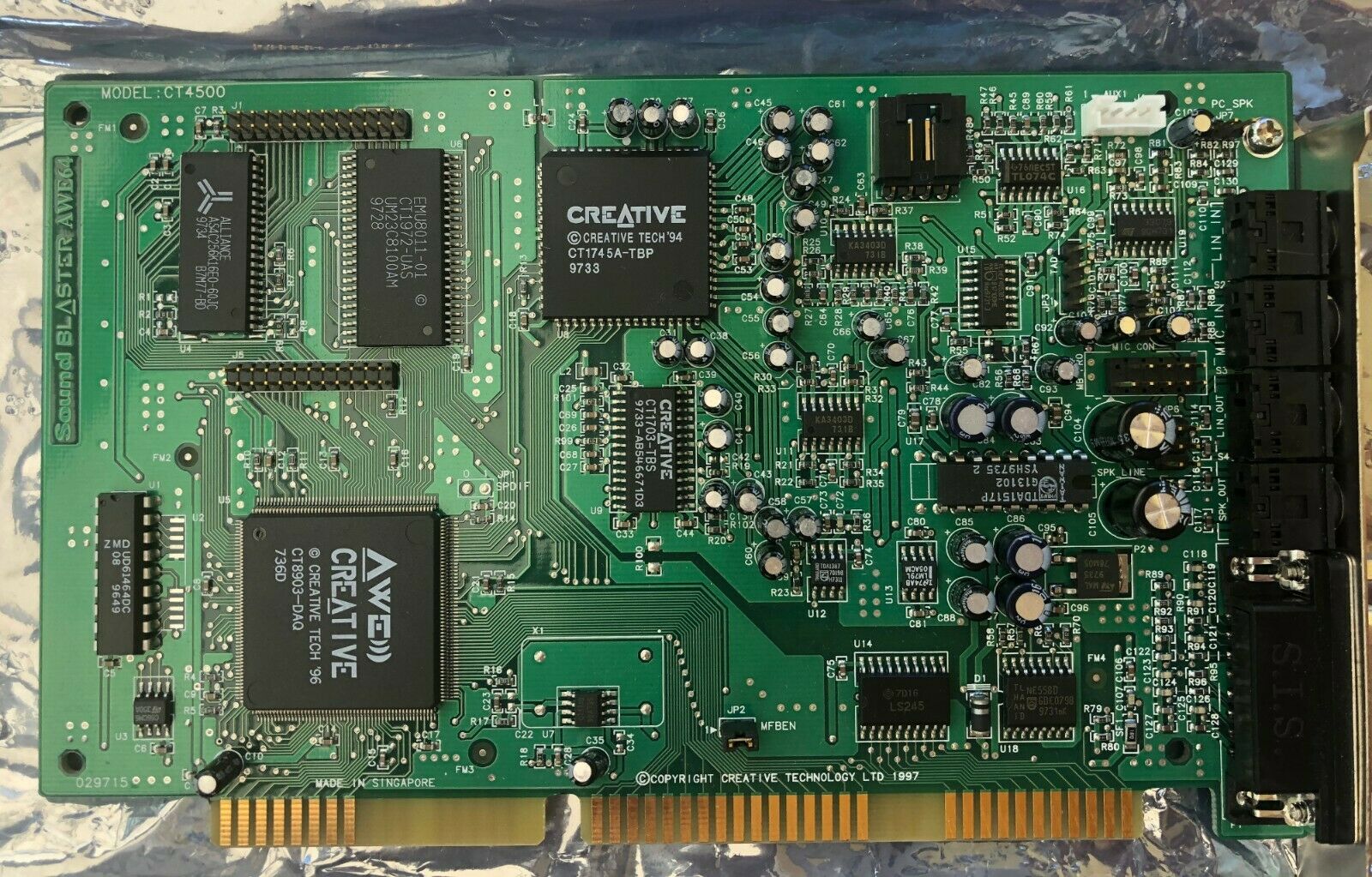Sound Blaster 32, AWE32 and AWE64
In March 1994, Creative Labs launched the AWE32 (Advanced Wave Effects) sound card, model number CT2760.
Visitors to the Comdex computer show in Las Vegas in November 1993 were given a glimpse of the next generation of audio technology from Creative - EMU8000, an integrated audio digital signal processing chip from E-Mu Systems, Inc. Founded in 1972, E-Mu had been a leader in recording, musical instrument, and file/video post-processing, and were now a wholly-owned subsidiary of Creative Labs. With this, Creative effectively took the Sound Blaster 16 and added a MIDI synthesizer with this EMU8000 chip.
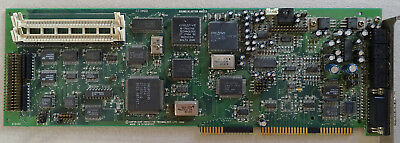
Creative Labs Sound Blaster AWE32, model CT3900 (1994)
The card therefore had two distinct sections: (1) the FM and digital audio section comprising an audio codec + optional CSP/ASP chip + Yamaha OPL3, and (2) the E-Mu synthesizer section, which consisted of the EMU8000 sample and effects processor, the EMU8011 one-megabyte sample ROM, and 512K of sample RAM, which was expandable to 28MB via two standard 30-pin SIMM slots. Using a supplied utility, this onboard RAM could be loaded with more samples.
The first AWE32 card, CT3900, was a full-length 14" (356 mm) 16-bit ISA card. This had a true Yamaha OPL3 chip, as did the CT2760 and CT3780 that followed.
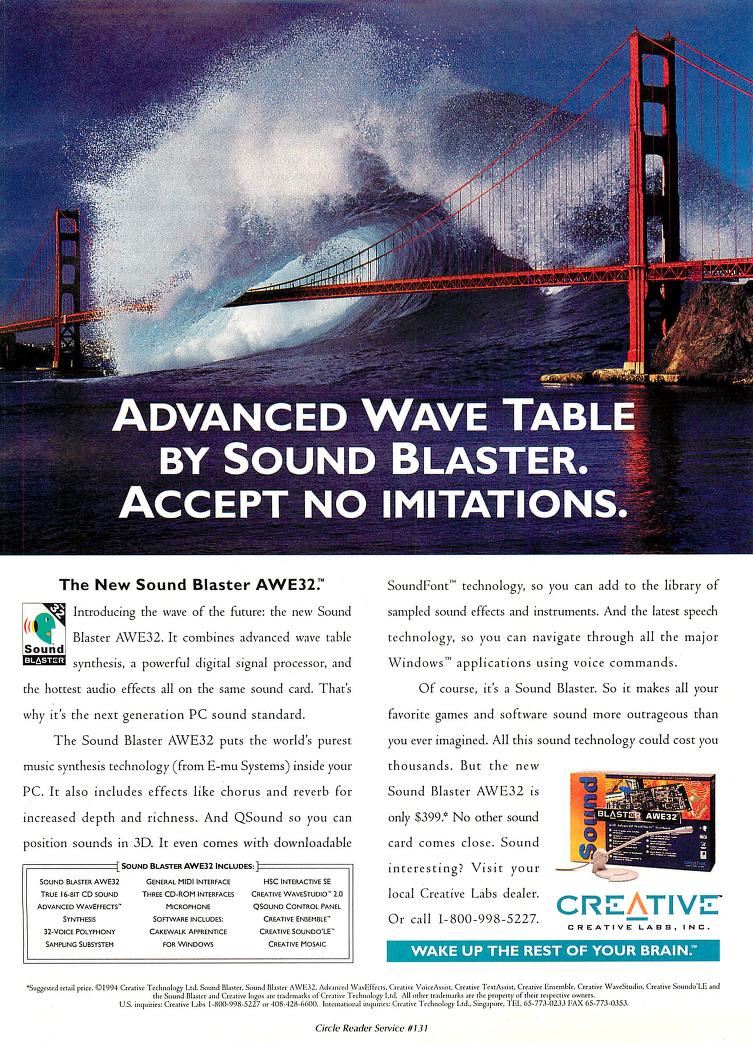
An Advertisement for the new AWE32
Computer Gaming World - October 1994
A year later in 1995, Creative launched the Sound Blaster 32 - a cut-down version of the AWE32, with no onboard RAM (it still came with two SIMM slots so you could add up to 8 MB of sample memory), no daughterboard connector, and it used the ViBRA chipset. Being cut-down, it was much cheaper than an AWE32.
In late 1996, the AWE64 was launched, CT-4380. This would be one of the last ISA-based sound cards from Creative. Creative did away with the daughterboard header just like they'd done with the Sound Blaster 32, but got greedy and added proprietary memory slots in which only Creative memory would work. The AWE64 is however a very good card - think of it as the end result of a big clean-up operation to tidy up mistakes made on earlier cards. It's functionally the same as the AWE32 but less "noisy" and is PnP (Plug and Play).
Noise Issues
Different DAC chips were used on the AWE32 and Sound Blaster 32, including CT1703-T, CT1703-TBS and CT1703-A. The CT1703-T is rumoured to be the cause of noise on these cards, so if possible, check what variant of the CT1703 is on the card before you buy it.
The CT1703-TBS is apparently decent for noise (low).
The CT1703-A is the most recent and quietest, and is found on numerous later SB16 cards up to AWE64 Gold.
So in order of preference when it comes to looking for an AWE32 or SB32, get a card with the CT1703-A, then the CT1703-TBS, and avoid cards with the CT1703-T completely. These cards are prolific so there is no reason to compromise.
The AWE64 has excellent low noise so you don't need to worry if you have any variant of the AWE64.
Muted OPL3 bug
All EMU8000-based cards have the "muted OPL3" bug. OPL3 is muted on some EMU8000 cards until you execute 'aweutil /s' or otherwise "flush" the card. On some examples, including the AWE64 Gold CT4540, it is not muted but is accompanied by quiet clicks which disappear after 'aweutil /s'. Some cards suffer from this bug right after boot, some just after listening to some EMU8000-synthesized music.
S/PDIF Output
Nearly all these cards have an S/PDIF output header, which is 2 pins. On the AWE64 non-Gold cards, you need to solder in a 2-pin socket, as these were omitted. The non-Gold AWE64 cards almost always have a pair of through holes which you could add a 2-pin SPDIF header.
S/PDIF outputs the EMU-8000 synth output. This is mixed with the FM synthesis if using a CT-1747 or CT-1978 (Creative's CQM - see further down) chip but not a discrete YMF-262 or YMF-289 chip. MIDI audio output from the Waveblaster header and CD Audio sound is **not** output through S/PDIF on any models. 16-bit digitised Sound Blaster audio will also be output on the AWE64 Gold cards, but this functionality may only work in Windows 95 or better.
Note that the AWE32 outputs a 5-volt TTL digital signal. This is the same signal that CD-ROM drives with a digital audio output header send out. They even use the same 2-pin header. The O is the output pin, the I is the ground pin. Not all S/PDIF inputs will accept this signal. Fortunately the CD Digital input header on a Sound Blaster Live! or Audigy will. Moreover, you can connect the pins to an optical/TOSLINK port output, which is accepted by lots of devices. Coaxial S/PDIF is designed for +0.5V to -0.5V peak-to-peak signals. This is what the Sound Blaster AWE64 Gold provides.
Yamaha OPL3 or CQM?
Non-Plug & Play (PnP) models have a CT-1747 bus interface chip which integrates a licensed Yamaha OPL3 core. They sound true to the Ad Lib and earlier Sound Blasters, but people have individual preferences of which card they like.
All the PnP models of the AWE32 and Sound Blaster 32 either have Creative Quadrature Modulaton (CQM) synthesis or Yamaha FM synthesis. On boards that have CQM, there will be a CT-1978 chip. CQM is generally not objectionable to the untrained ear, but it often sounds harsher and more metallic but slightly crisper compared to a Yamaha FM chip. Most boards have a silkscreen for a Yamaha YMF-278 and its DAC (very small chips). Finding boards with the CQM chips are much more common. However, if you find a board with the Yamaha chip, note that you will not be able to run the chip's output through the EMU-8000 effects processor.
AWEUTIL is used on the AWE cards to initialize the FM synthesis output and can be used to apply reverb and chorus effects on the CT-1747 cards through the EMU-8000 chip. I am uncertain whether cards with a discrete YMF-278 can do that, and the AWE32 "Upgrade" cards probably cannot as well.
AWEUTIL is also needed for General MIDI support under DOS to work, and since the GM implementation on these cards is done partly in software, it can be hit-or-miss with protected mode games like those that use DOS4GW or other DOS extenders.
Creative's CSP (aka QSound ASP)
The original AWE32 had, as standard, the CT-1748 QSound Advanced Signal Processor (ASP), later known as the Creative Signal Processor (CSP), which was an optional upgrade in the Sound Blaster 16. All full-length AWE32s should have one soldered onto the PCB. The AWE32 Value cards have a socket for this chip, which you could purchase from Creative Labs. The SB32s and AWE64s do not have any support for the chip, as they were pretty outdated by 1995.
All boards with the chip or socket, even if they are otherwise PnP, will have two jumpers to enable or disable the chip.
Game Support
The vast majority of DOS games that supported the Sound Blaster AWE32 or AWE64 merely used the 1 MB of samples contained in the ROM on the card. However, a handful of titles do what a lot of Roland-supported games do, and upload their own custom samples into the card's RAM. Because of this, they potentially require some RAM sticks to be installed on your sound card. The AWE64 Gold has 4 MB RAM onboard which is a nice starter, the AWE64 Standard has 1 MB RAM, and the AWE64 Value has 512 KB RAM.
The following games are known to have made use of the onboard RAM for more sample storage:
- Battle Arena Toshinden
- Dungeon Keeper
- Eradicator
- Hi-Octane
- Magic Carpet 2
- Nerves of Steel
- Perfect General II
- Terra Nova: Strike Force Centauri
SO IN SUMMARY.....
Of these three "families" of sound card (SB32, AWE32 and AWE64), here's a basic thing to keep in mind:
Sound Blaster AWE32 = a Sound Blaster 16 + EMU8000 hardware synth
Sound Blaster AWE64 = a Sound Blaster 16 + EMU8000 hardware synth + a software synth
So in terms of which is best, in descending order (best to worst), I would say:
- Sound Blaster AWE64 Gold (4 MB, RAM upgradable. No wavetable header)
- Sound Blaster AWE64 Standard (1 MB, RAM upgradable. No wavetable header)
- Sound Blaster AWE64 Value (512 KB, RAM upgradable. No wavetable header)
- Sound Blaster AWE32 (512 KB, RAM upgradable. Wavetable header)
- Sound Blaster AWE32 Value (512 KB, NOT upgradable. No wavetable header)
- Sound Blaster 32 (0 KB, RAM upgradable. No wavetable header)
Games that use General MIDI for their soundtracks will benefit from the hardware synthesizer on the AWE cards. The additional 32 voices on the AWE64 are provided by a software synth that won't run under DOS so for DOS games, the AWE32 and AWE64 are pretty much equivalent. The AWE64 Gold also differs in that it had gold-plated RCA stereo output jacks.
AWE32
All AWE32 boards support a maximum of 28 MB of RAM, and if the RAM sockets are used the onboard 512 KB of RAM is disabled. For AWE32 cards use 30-pin SIMMs that are 80ns or faster, and always use the same size sticks in each slot (1 MB, 4MB or 16 MB) - you do need to populate both sockets as they make up 1 bank of memory.
Since I find PnP (Plug & Play) cards to be more trouble than they are worth, I would stick with the non-PnP AWE32s. This is especially true if you're exclusively running DOS games, since DOS doesn't support PnP. Feature-wise, the best of the bunch is the CT3980, then the CT3900 and finally CT2760. However, since the CT3980 is a PnP card, I would pick the CT3900 or CT2760 first over a CT3980. The CT2760 uses the older CT1701 CODEC chip (known for its higher noise) while the CT3900 uses the newer CT1703 CODEC chip. The later CODEC chip has been said to have a cleaner output compared with the older CODEC (see Noise Issues further up).
Rich Heimlich had this to say about the AWE-32: "The patch set is average, it requires LARGE TSR's or direct support if you want to use it with games and is less compatible with the SB family than the SB-16 which wasn't ever a great SB-compatible. It's also expensive. The only real benefit is the ability to load RAM patches.". He scored the AWE32's digital quality at a lowly 5 out of 10, and music quality at 6 out of 10.
This comment about the large TSR is sadly true - for more information on AWE32 configurations, see my separate page that covers that.
|
|
|
|
I don't have any information on the CT3620. |
|
AWE32 Value. |
|
|
|
|
|
|
|
|
|
|
|
|
|
|
|
|
|
Sound Blaster 32
The Sound Blaster 32 (CT3930) was a cut-down version of the AWE32, released in 1995. It retained the AWE32's EMU8000 and EMU8011 MIDI engine and ROM, but had no onboard RAM. Instead it got two 30-pin SIMM slots for up to 8MB RAM to be added by the owner. Also, no MIDI daughterboard header, and no CSP/ASP chip socket. It made use of the ViBRA chip to reduce component count, so bass/treble/gain control was limited by comparison to the AWE32.
All EMU8000-based cards have the "muted OPL3" bug. OPL3 is muted on some EMU8000 cards until you execute 'aweutil /s' or otherwise flush the card. On some exemplars (including the AWE64 Gold CT4540) it is not muted, but accompanied by quiet clicks which disappear after 'aweutil /s'. Some cards suffer from this bug right after boot, some just after listening to some EMU8000-synthesized music.
The EMU8000 has very little on-board intelligence. It requires extensive initialization on power-up before any use can be made of its facilities. This initialization phase configures it for the SB32/AWE32 environment, brings the chip to a known, silent state, and enables audio output. Once the EMU8000 has been initialized, sounds can be played, or Sound DRAM can be loaded with additional sounds.
|
|
|
|
|
AWE64
In November 1996, the AWE64 was launched at a cost of $230. This was a much shorter half-length 16-bit ISA card than the AWE32, and added support for greater polyphony through 32 extra software-emulated channels (64 voices in all). Unfortunately, Creative decided to replace the standard 30-pin SIMM slots from the AWE32/SB32 with a proprietary memory format, making upgrades very expensive. There are two third-party RAM expansion daughterboards that convert the Creative proprietary RAM slot to accept regular SIMMs. One is the AWE-SIMM which accepts 30-pin SIMMs, and the other is the SIMMConn which accepts a single 72-pin SIMM.
The AWE64 however, did get better backward-compatibility with older Sound Blaster models, an improved signal-to-noise ratio than the AWE32/SB32, and a rather gimmicky 3D positional audio feature which provided a fake 3D effect. An AWE64 "Value" card (CT4500, CT4501, and CT4520) got just 512K of RAM, a "Standard" card got 1MB of RAM, and a "Gold" version (CT4390) got 4MB of RAM plus an S/PDIF output.
All AWE64s use DSP version 4.16, so there's no "hanging notes" MIDI bug. Most AWE cards prior to the AWE64 use DSP version 4.13, and this version does suffer from the "hanging notes" bug. The bug only occurs when both digital sounds and MIDI are being played. The standard workaround if you have this problem is to use a separate card for the MIDI output. The bug is not present on any card that uses the CT-1747 bus interface chip.
The AWE64, like the Sound Blaster 32, doesn't come with a MIDI daughterboard header, so no ability to add a Wave Blaster, Roland SCB-7, SCB-55, or Yamaha DB50XG/DB60XG. This puts a lot of buyers off the AWE64, but it shouldn't. The card has a lot going for it! It doesn't suffer from the same "cutoff" noises at the end of digital speech, no popping on reboot, you avoid the cheap Sound Blaster mixer, and if you get an external Sound Canvas or similar this card has line inputs on the rear to connect your AWE64 to it anyway. It also has an S/PDIF (Coax out) so it's possible to get digital speech out of the card with absolutely no noise!
To replace the missing daughterboard header, instead the AWE64 uses a 32-note polyphonic software wavetable synthesizer called WaveSynth/WaveGuide. This software synthesizer has been reported to use between 10-%15% of your CPU power. There are also reports that WS/WG doesn't work on Cyrix CPUs.
Game compatibility is excellent. No it doesn't have a true OPL3 chip for FM synthesis, and it does sound a bit different as it's emulated inside the EMU-8000 chip, but it's still good. AWE64 will also work just fine on any AWE32-enabled game. It's not 100% Sound Blaster Pro-compatible since it doesn't support SBPro in stereo speech mode, but this isn't really a problem as no games require this that don't also support Sound Blaster 16.
The Gold edition has 4 MB onboard for wavetable samples. The Standard edition had 1 MB onboard, and the Value editions have 512 KB onboard.
|
||
CT4381Onboard RAM for wavetable samples: 1 MB. An OEM version of the CT4380. |
||
|
||
|
More Images
 CT4520
CT4520
Introduced: 1997
Onboard RAM for wavetable samples: 512 KB.
Plug & Play: Yes
Known Board Revisions: 19729
The final "Value" edition. Two key differences when compared to the CT4500:
1) Added colour-coding to the output sockets
2) The two main chips from the CT4500 (the 8903 and 1745A) have been integrated into a single chip, 8920.
Be warned there are some crippled versions with the same PCB wording "Model CT4520", but with most of the chips missing as well as the wavetable header. These were supposedly sold to OEMs (Dell or Packard-Bell perhaps), and effectively made these cards into a straight Sound Blaster 16. In the Creative Sound Blaster Products list, these are called CT4525.
CT4540
Another "Gold" edition, complete with 4 MB RAM for additional wavetable samples.
If you have a CQM chip, both the FM output and the EMU-8000 audio is passed through to the S/PDIF. Unfortunately the Wavetable header output and CD audio is not.
Drivers and Install Disks
AWE32 Revision 3 (CT2760a) Floppy Disk Images
AWE Control Panel for Win95
AWE Upgrade drivers for Win31/95
Installation Program Loader for SB16/AWE32/AWE64
Creative CR-563 CD-ROM driver disk(.imz floppy disk image format)
Sound Blaster 16/AWE32 Drivers Disk for Windows NT 3.5 (revision 1)
AWE64 Basic DOS and Windows 3.1 Installation disk
AWE64 software & drivers for Win9x, WinNT 4.0, OS/2 Warp




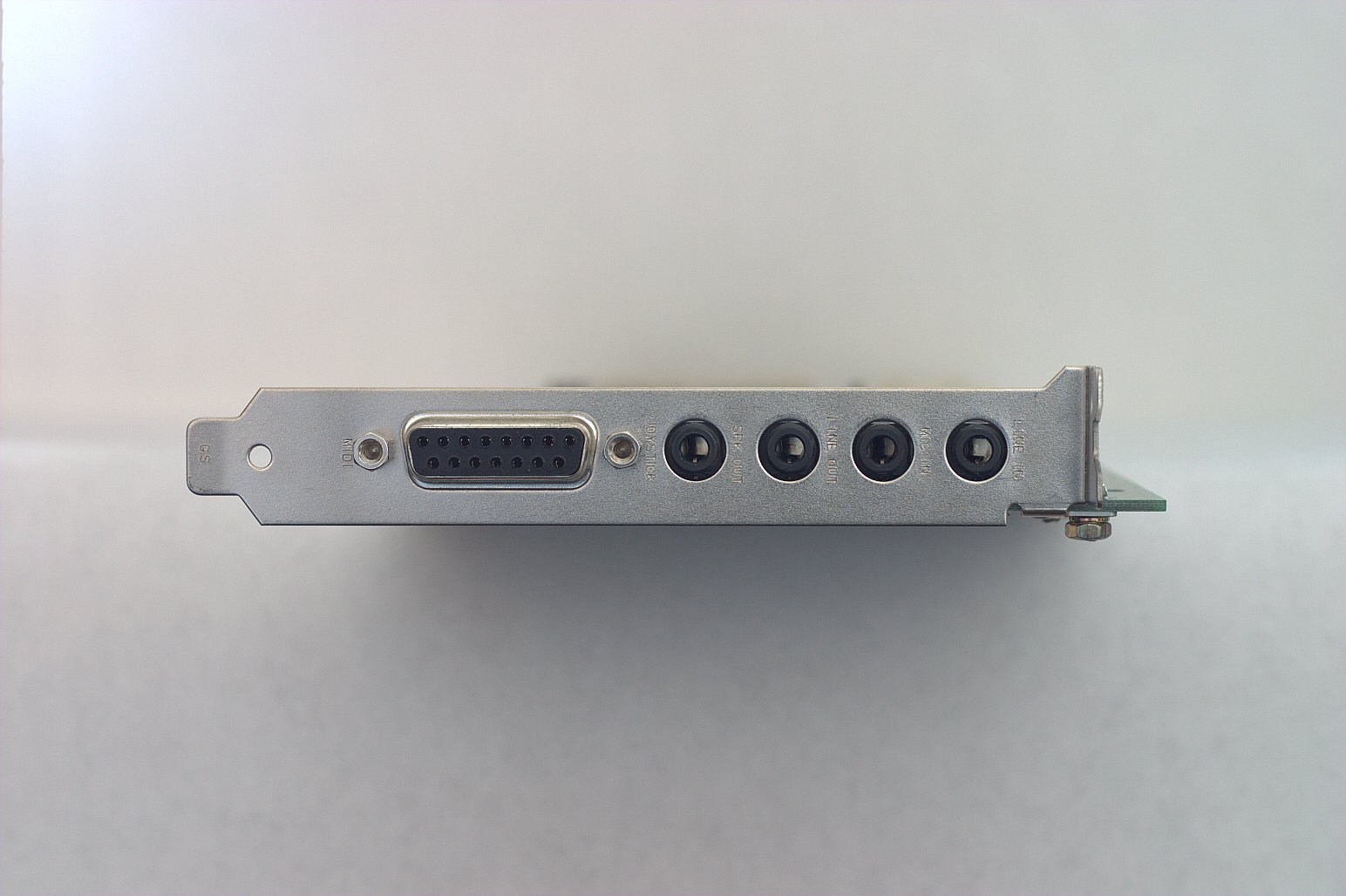
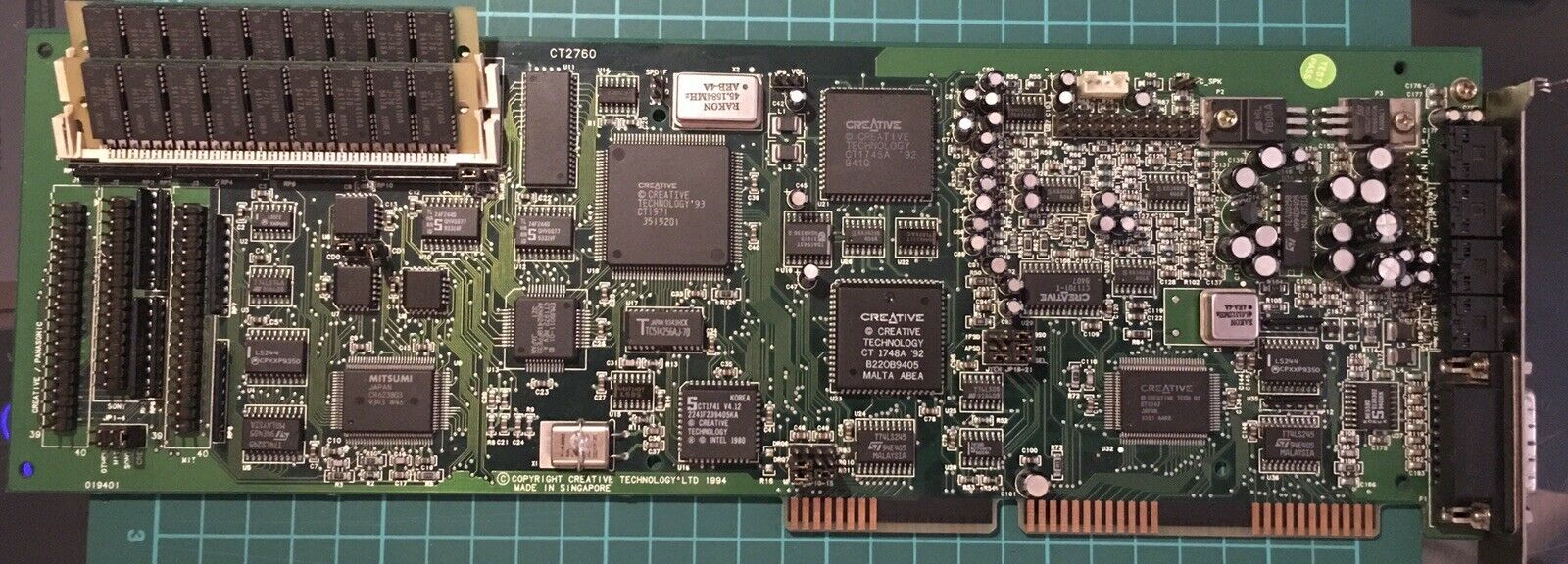






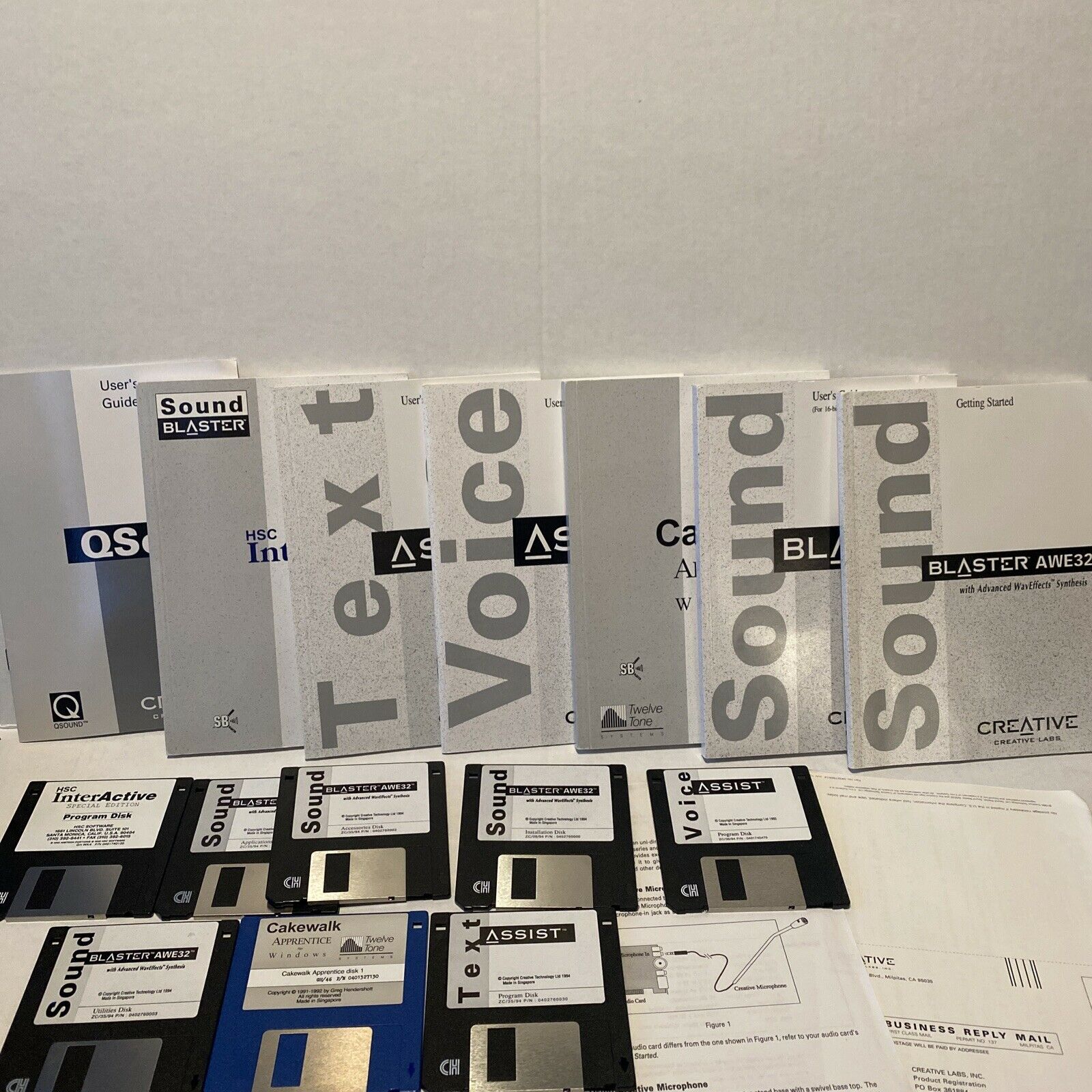


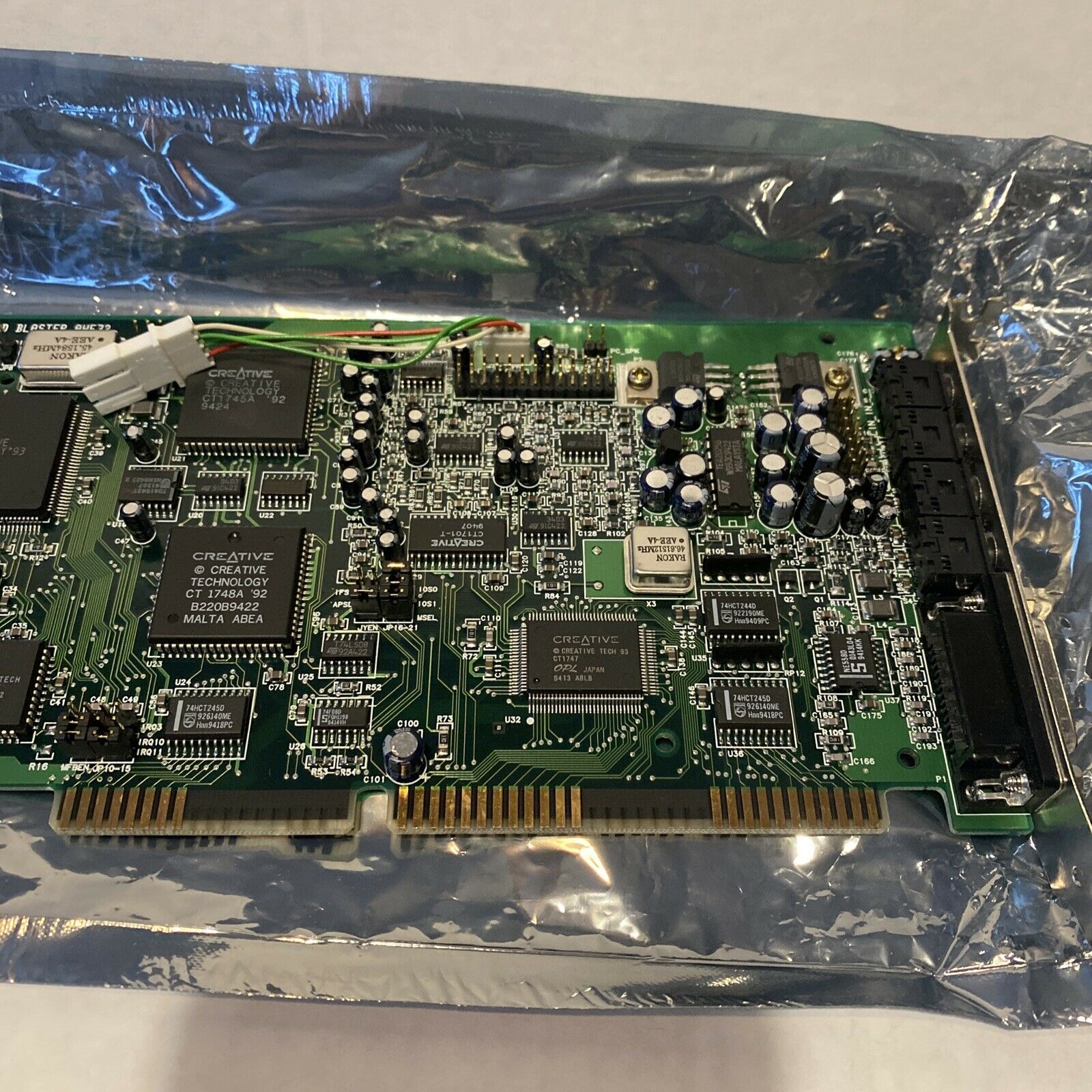

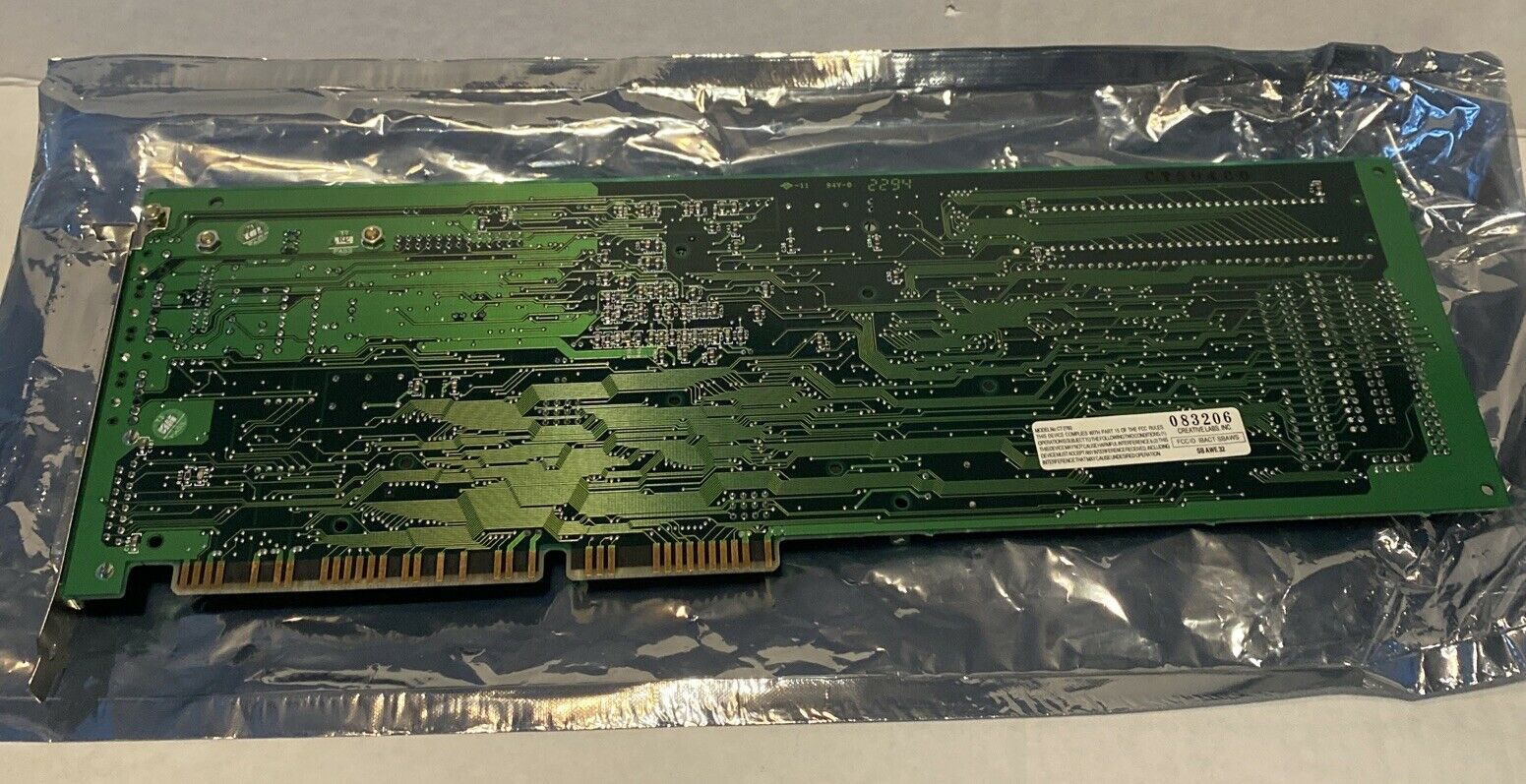


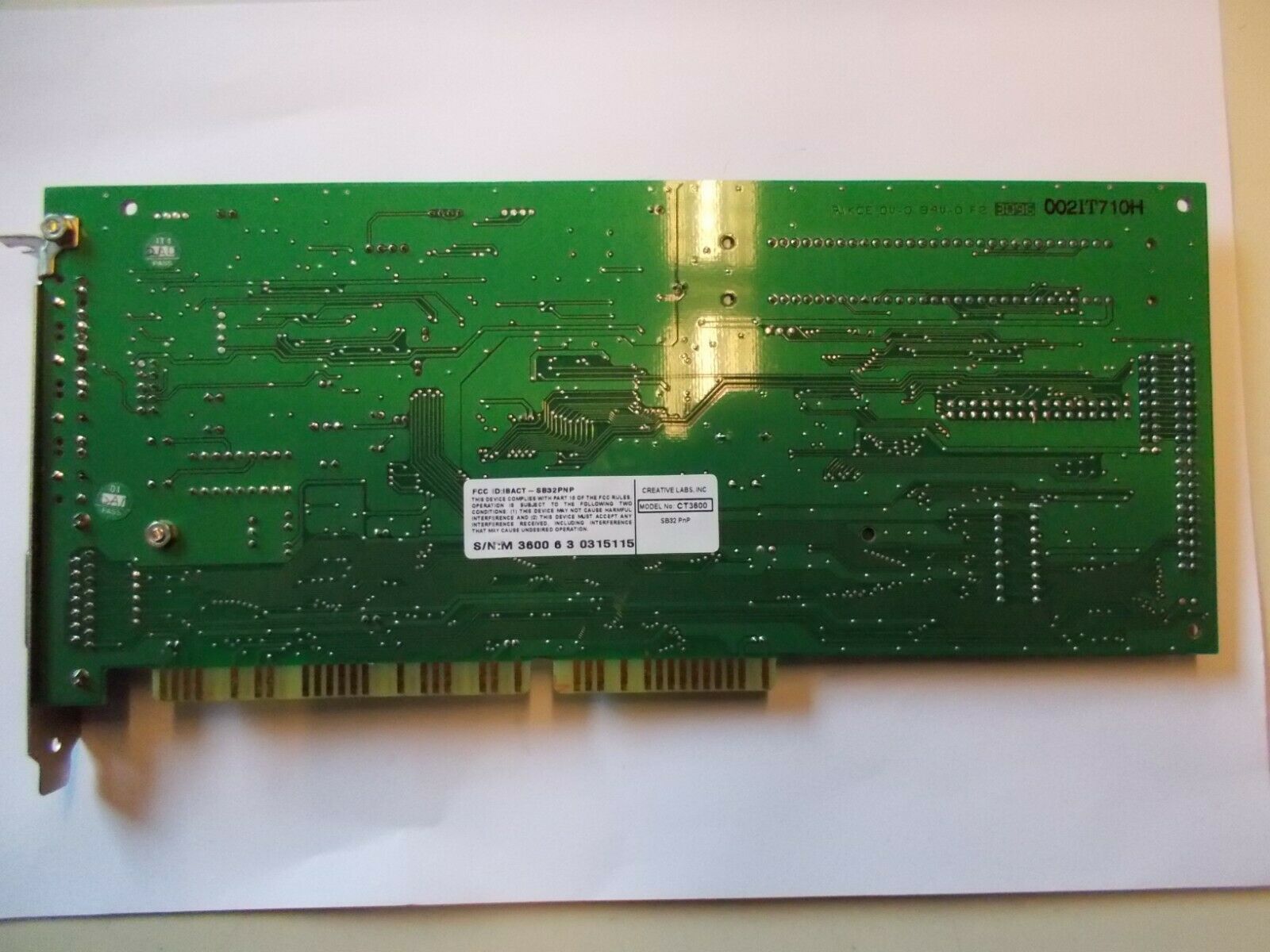
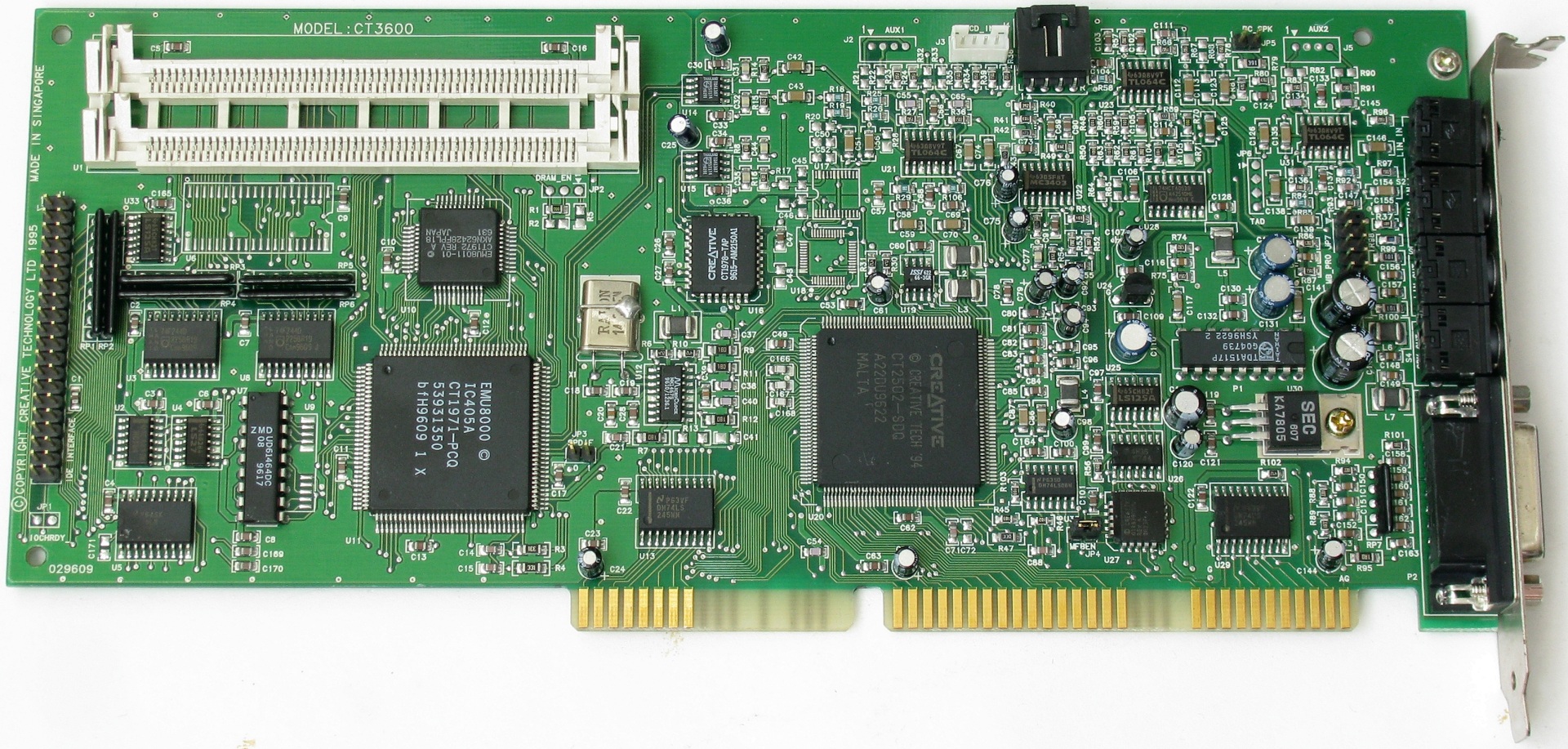




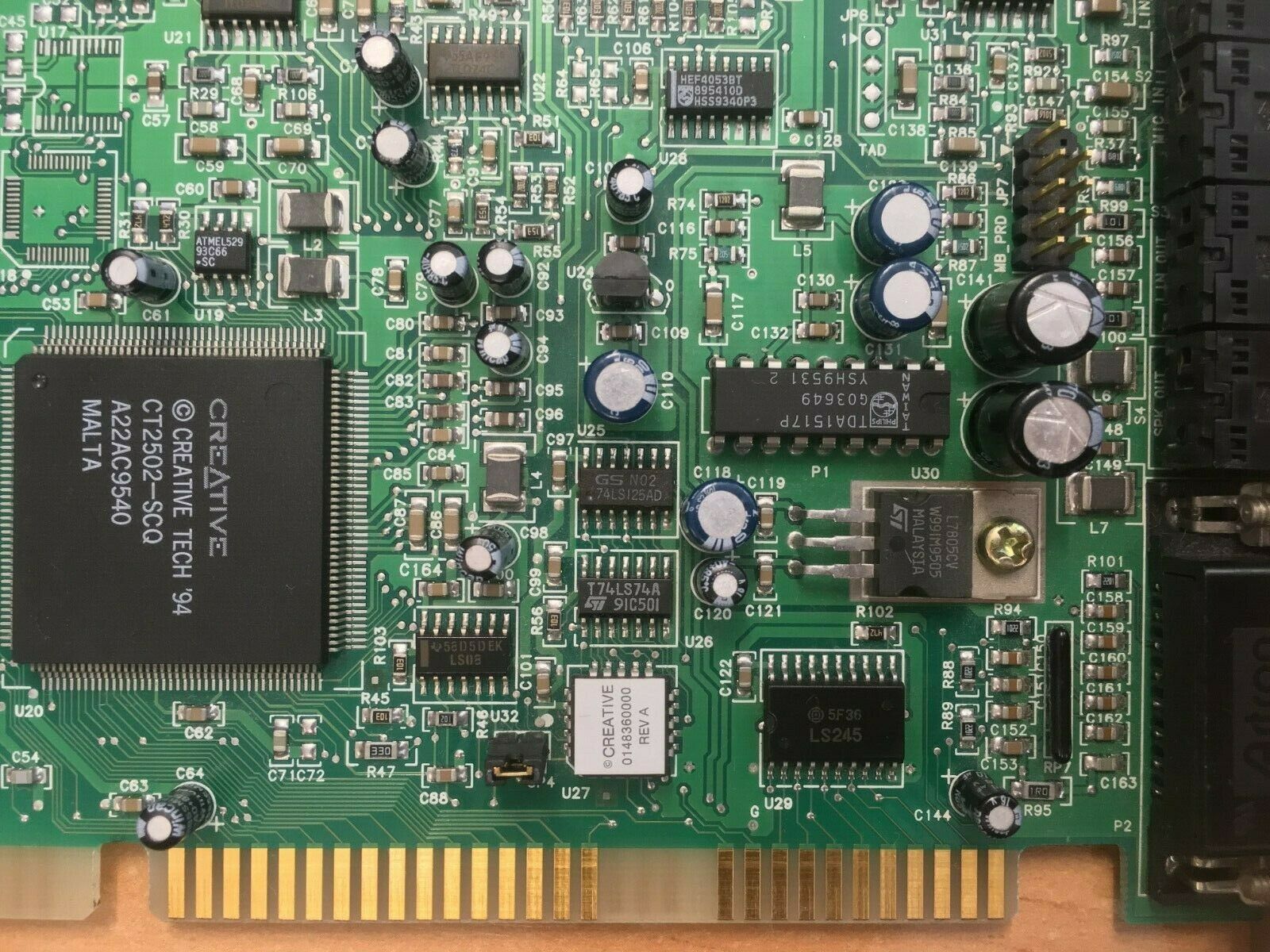



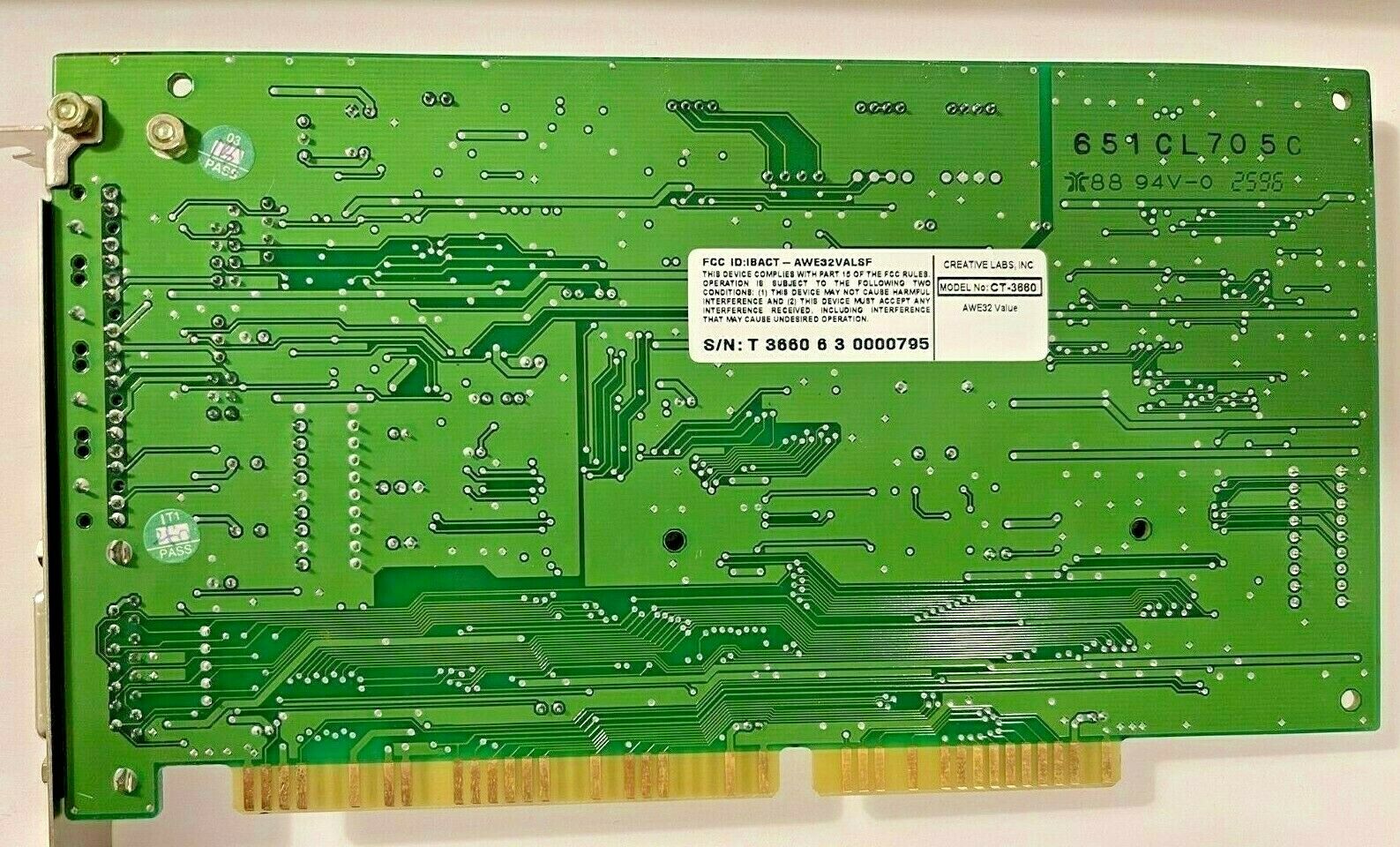
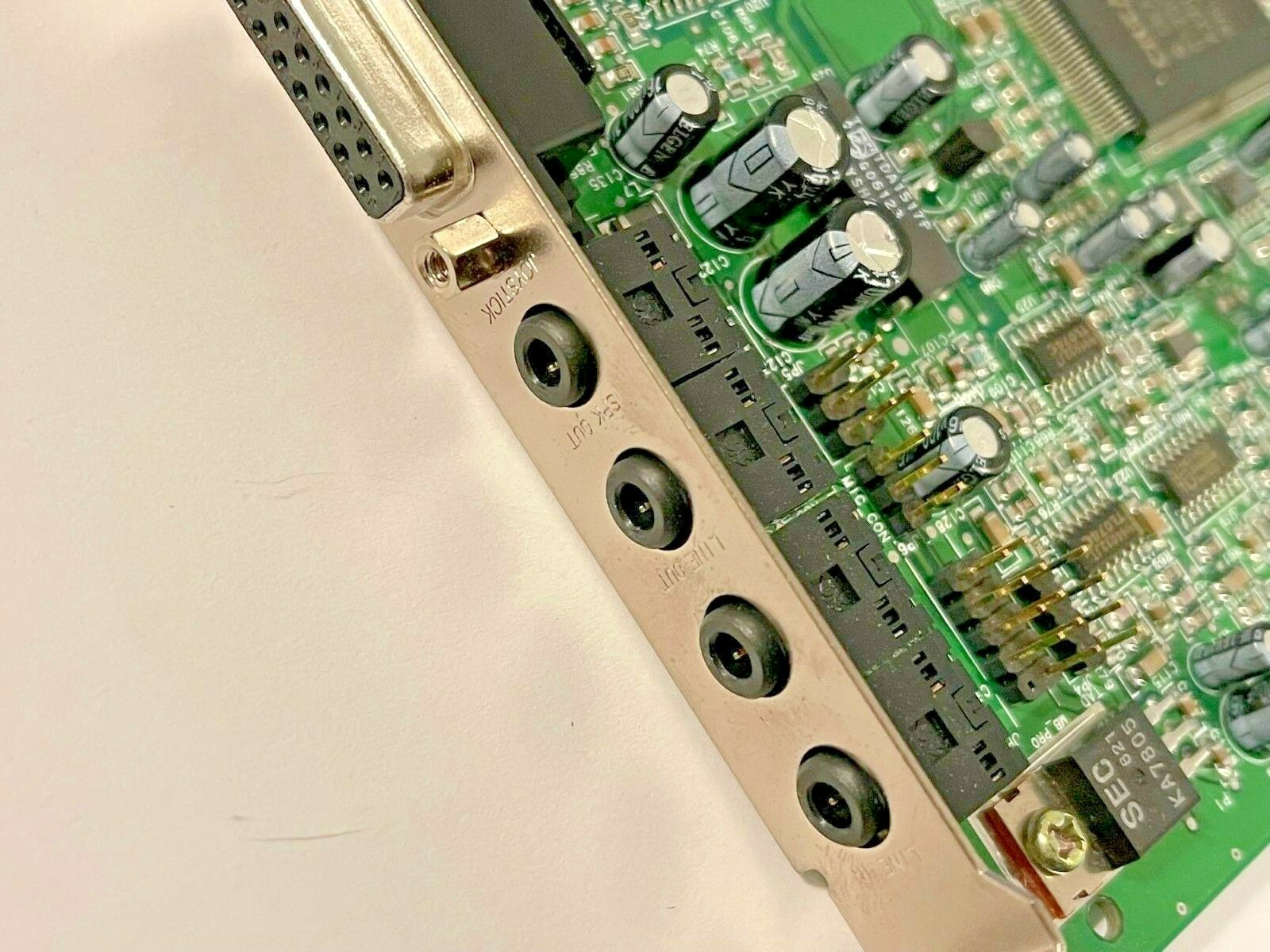

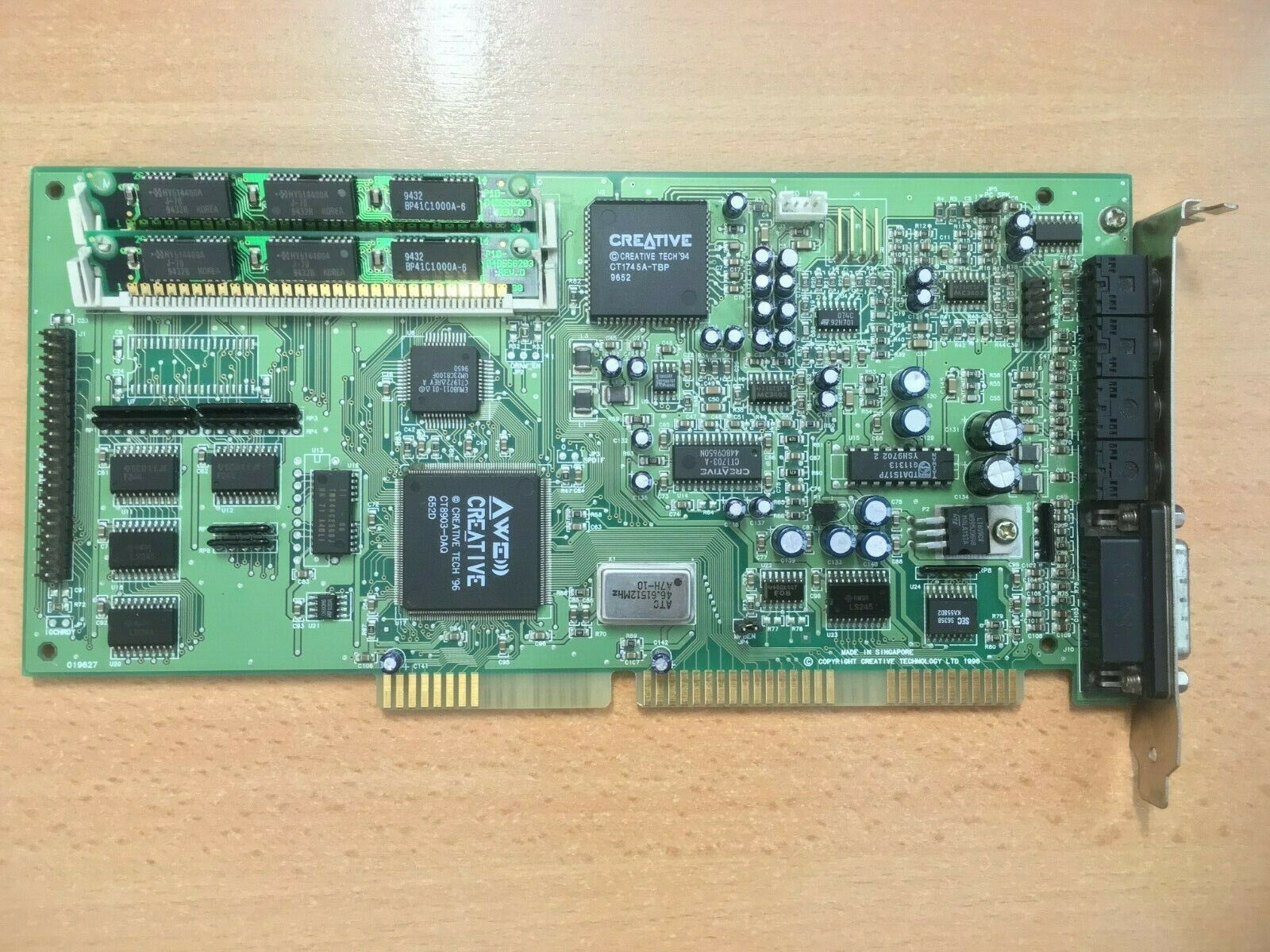




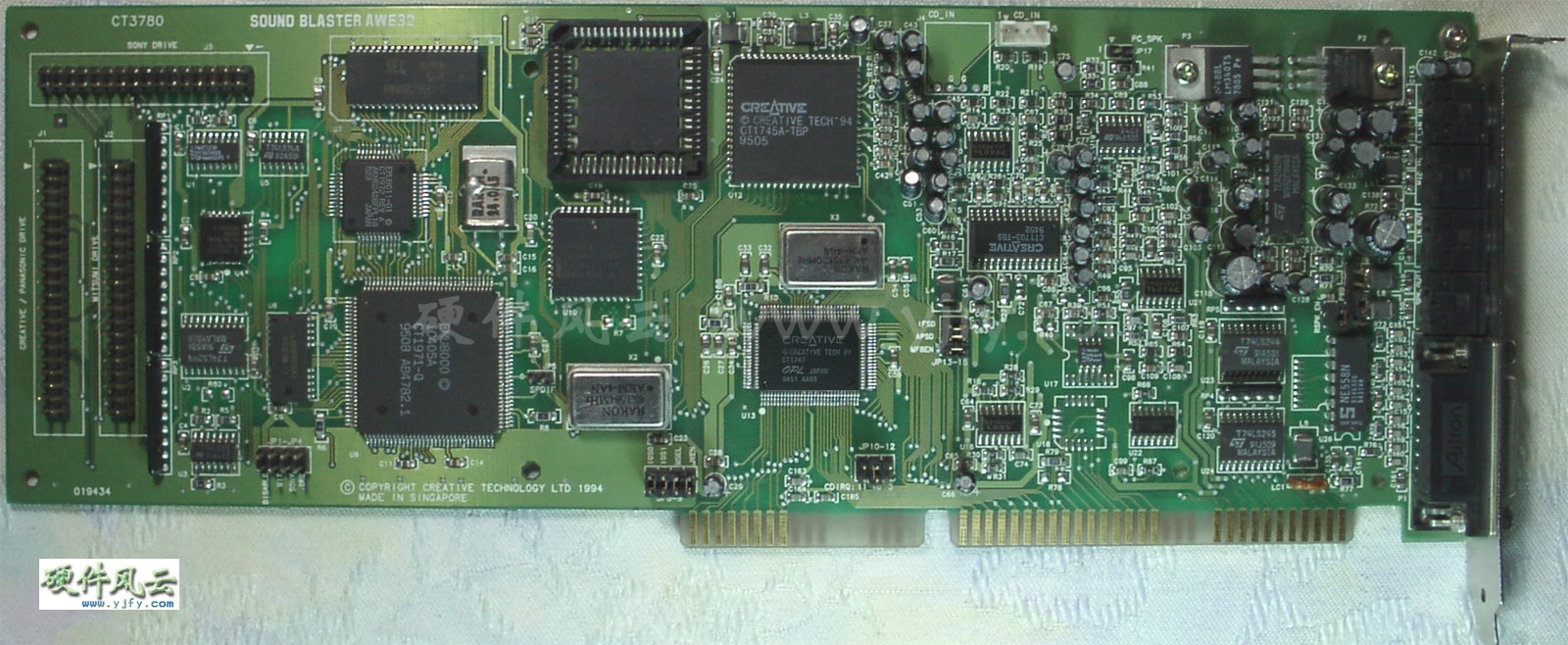
.jpg)





